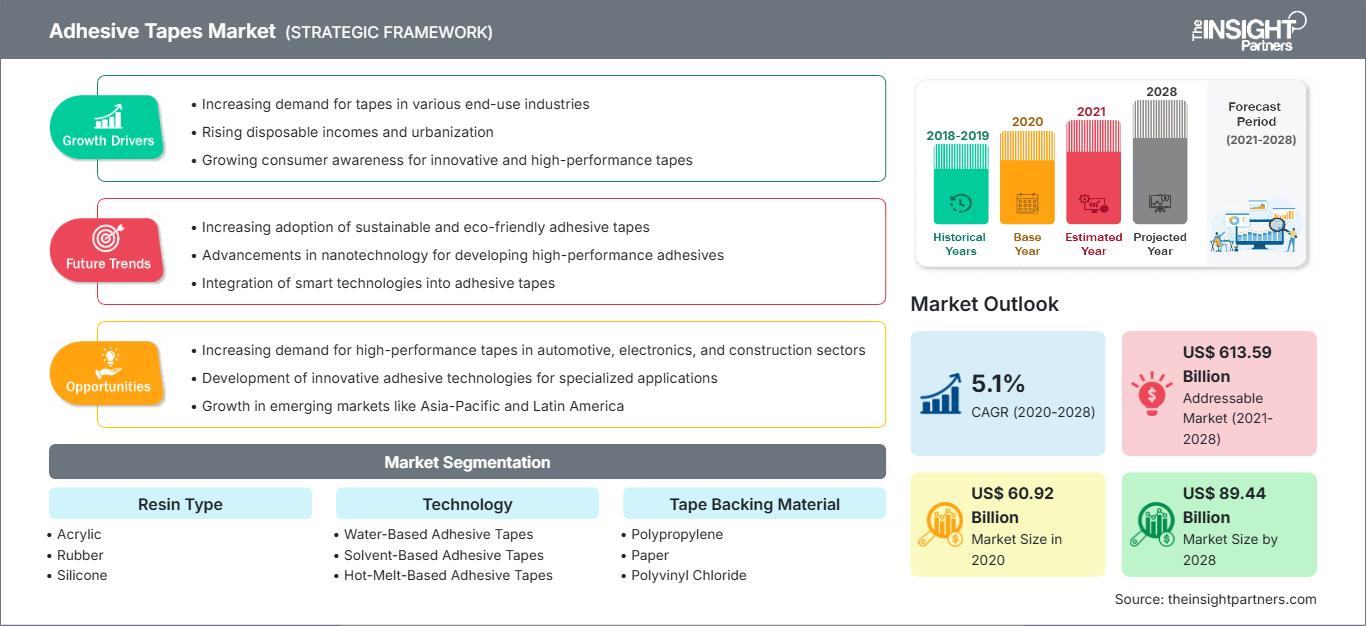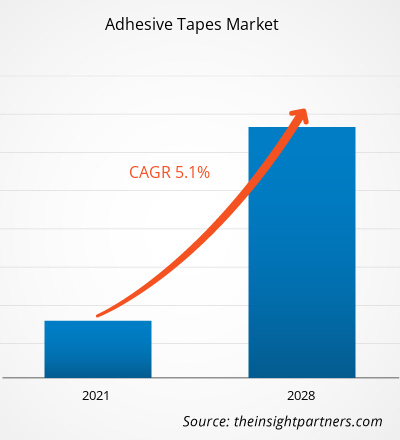Il mercato dei nastri adesivi è stato valutato a 60.922,61 milioni di dollari nel 2020 e si prevede che raggiungerà gli 89.440,92 milioni di dollari entro il 2028; si prevede una crescita a un CAGR del 5,1% dal 2021 al 2028.
I nastri adesivi sono disponibili in due tipologie: nastri speciali e nastri standard. Le tecnologie di rivestimento utilizzate nei nastri adesivi sono a base d'acqua, a base di solvente e hot-melt. I progressi tecnologici hanno portato alla crescente domanda di materiali di supporto leggeri nel recente passato. I nastri adesivi offrono un'ampia gamma di applicazioni nei settori dell'imballaggio, automobilistico e sanitario.
Nel 2020, l'area Asia-Pacifico deteneva la quota maggiore del mercato globale dei nastri adesivi. Si stima inoltre che registrerà il CAGR più elevato del mercato durante il periodo di previsione. Si prevede che la domanda di nastri adesivi aumenterà nella regione a causa di diversi fattori, tra cui l'ampia base demografica, l'aumento del reddito disponibile e il miglioramento del tenore di vita. Anche la crescita del mercato automobilistico ha stimolato la domanda di nastri adesivi nella regione Asia-Pacifico. Questi fattori hanno anche attratto operatori stranieri a espandere le loro attività nella regione. Inoltre, la rapida crescita della regione Asia-Pacifico è attribuita alla crescita del settore edile nella regione. La Cina è il più grande mercato edile al mondo e si prevede una crescita significativa nei prossimi anni. Inoltre, anche altre economie, come l'India, sono destinate a crescere a un ritmo elevato, con l'obiettivo di potenziare le attività manifatturiere nazionali.
L'impatto della pandemia di COVID-19 sul mercato globale dei nastri adesivi è eterogeneo. Diversi settori, come quello automobilistico, edile, elettronico ed elettrico, hanno registrato forti cali. Al contrario, il settore sanitario è cresciuto sin dall'inizio dell'epidemia a causa dell'eccessiva domanda di kit di protezione individuale (DPI) e apparecchiature mediche. Con la ripresa economica, diversi settori ed economie stanno pianificando strategicamente di investire nel settore sanitario. Si prevede che ciò darà impulso alla crescita del mercato dei nastri adesivi. Le iniziative in ambito sanitario comprendono l'acquisto di dispositivi medici professionali e di protezione individuale (DPI), l'espansione delle capacità di ricerca, l'assunzione di personale e benefit aggiuntivi, il supporto a ospedali ed enti locali e la donazione di fondi per la produzione di vaccini. Inoltre, molte aziende come 3M Company, Tesa SE e Nitto Denko Corporation hanno iniziato a commercializzare attivamente il prodotto per espandere la propria base clienti e ridurre l'impatto commerciale.
Personalizza questo rapporto in base alle tue esigenze
Potrai personalizzare gratuitamente qualsiasi rapporto, comprese parti di questo rapporto, o analisi a livello di paese, pacchetto dati Excel, oltre a usufruire di grandi offerte e sconti per start-up e università
Mercato dei nastri adesivi: Approfondimenti strategici

- Ottieni le principali tendenze chiave del mercato di questo rapporto.Questo campione GRATUITO includerà l'analisi dei dati, che vanno dalle tendenze di mercato alle stime e alle previsioni.
Approfondimenti di mercato: ampia gamma di applicazioni dei nastri adesivi
Potrai personalizzare gratuitamente qualsiasi rapporto, comprese parti di questo rapporto, o analisi a livello di paese, pacchetto dati Excel, oltre a usufruire di grandi offerte e sconti per start-up e università
Mercato dei nastri adesivi: Approfondimenti strategici

- Ottieni le principali tendenze chiave del mercato di questo rapporto.Questo campione GRATUITO includerà l'analisi dei dati, che vanno dalle tendenze di mercato alle stime e alle previsioni.
I nastri adesivi sono combinazioni di materiali e pellicole adesive utilizzate per incollare o unire oggetti anziché utilizzare viti, elementi di fissaggio o saldature. Il nastro può proteggere la superficie senza richiedere elementi di fissaggio o viti, rendendolo quindi utile per varie applicazioni in settori come l'imballaggio, la sanità, l'automotive, l'elettrico e l'elettronica e l'edilizia. Gli adesivi liquidi sono disordinati e richiedono molto tempo perché devono essere spruzzati o stesi sulla superficie prima dell'incollaggio. I nastri adesivi trovano importanti applicazioni in settori come l'imballaggio, la sanità, l'automotive, l'elettrico e l'elettronica e l'edilizia.
Approfondimenti sulle applicazioni
In base all'applicazione, il mercato globale dei nastri adesivi è segmentato in imballaggio, sanità, automotive, elettrico ed elettronico, edilizia e costruzioni e altri. Il segmento automobilistico ha guidato il mercato nel 2020. I nastri adesivi hanno molteplici applicazioni nel settore automobilistico. All'interno dei veicoli, i nastri adesivi vengono utilizzati per gli elementi riscaldanti dei sedili, il rivestimento e il fissaggio degli airbag, il rivestimento del volante, il montaggio in gomma, i profili in plastica e il fissaggio di schiuma e tessuto sul cruscotto. Negli interni delle auto con caratteristiche come attacchi per dispositivi mobili, caricabatterie elettronici, purificatori d'aria, connessioni per congelatori portatili e altri componenti, i nastri adesivi vengono utilizzati per il fissaggio e l'incollaggio. Inoltre, vengono utilizzati per sviluppare componenti elettronici per autoveicoli, come gruppi ottici, sistemi di climatizzazione, pannelli di visualizzazione elettronici, connettori e cavi per batterie e sensori. Inoltre, i nastri adesivi stanno rapidamente sostituendo i bulloni di fissaggio per ridurre il peso del veicolo e migliorarne l'estetica. Si prevede che la crescente domanda di guarnizioni leggere nei veicoli e il crescente utilizzo di nastri adesivi nella produzione di veicoli elettrici rafforzeranno la crescita del mercato dei nastri adesivi nei prossimi anni.
Alcuni dei principali attori del mercato che operano nel mercato dei nastri adesivi sono 3M, Nitto Denko Corporation, tesa SE, Avery Dennison Corporation, Intertape Polymer Group, LINTEC Corporation, Berry Global Inc, Scapa, Lohmann GmbH & Co.KG e Rogers Corporation.
In evidenza nel rapporto
- Tendenze progressive del settore nel mercato globale dei nastri adesivi per aiutare gli operatori a sviluppare strategie efficaci a lungo termine
- Strategie di crescita aziendale adottate dai mercati sviluppati e in via di sviluppo
- Analisi quantitativa del mercato globale dei nastri adesivi dal 2019 al 2028
- Stima della domanda di nastri adesivi in vari settori
- Analisi PEST per illustrare l'efficacia di acquirenti e fornitori che operano nel settore nel prevedere la crescita del mercato
- Sviluppi recenti per comprendere lo scenario competitivo del mercato e la domanda di nastri adesivi
- Tendenze e prospettive di mercato, insieme ai fattori che guidano e frenano la crescita del mercato dei nastri adesivi
- Processo decisionale attraverso la comprensione delle strategie che sostengono l'interesse commerciale per quanto riguarda la crescita del mercato globale dei nastri adesivi
- Dimensioni del mercato dei nastri adesivi in vari nodi del mercato
- Panoramica dettagliata e segmentazione del mercato globale dei nastri adesivi, nonché le sue dinamiche nel settore
- Dimensioni del mercato dei nastri adesivi in varie regioni con promettenti opportunità di crescita
Il rapporto segmenta il mercato globale dei nastri adesivi come segue:
- Per tipo di resina, il mercato dei nastri adesivi è segmentato in acrilico, gomma, silicone, altri.
- Per tecnologia, il mercato dei nastri adesivi è segmentato in nastri adesivi a base d'acqua, nastri adesivi a base di solvente e nastri adesivi a base di hot-melt.
- Per materiale di supporto del nastro, il mercato dei nastri adesivi è segmentato in polipropilene (PP), carta, cloruro di polivinile (PVC), altri.
- Per applicazione, il mercato dei nastri adesivi è segmentato in imballaggio, sanità, automobilistico, elettrico ed elettronico, edilizia e costruzioni, altri.
Mercato dei nastri adesivi
Le tendenze regionali e i fattori che influenzano il mercato dei nastri adesivi durante il periodo di previsione sono stati ampiamente spiegati dagli analisti di The Insight Partners. Questa sezione analizza anche i segmenti e la distribuzione geografica del mercato dei nastri adesivi in Nord America, Europa, Asia-Pacifico, Medio Oriente e Africa, America meridionale e centrale.
Ambito del rapporto di mercato sui nastri adesivi
| Attributo del rapporto | Dettagli |
|---|---|
| Dimensioni del mercato in 2020 | US$ 60.92 Billion |
| Dimensioni del mercato per 2028 | US$ 89.44 Billion |
| CAGR globale (2020 - 2028) | 5.1% |
| Dati storici | 2018-2019 |
| Periodo di previsione | 2021-2028 |
| Segmenti coperti |
By Tipo di resina
|
| Regioni e paesi coperti | Nord America
|
| Leader di mercato e profili aziendali chiave |
|
Densità degli operatori del mercato dei nastri adesivi: comprendere il suo impatto sulle dinamiche aziendali
Il mercato dei nastri adesivi è in rapida crescita, trainato dalla crescente domanda degli utenti finali, dovuta a fattori quali l'evoluzione delle preferenze dei consumatori, i progressi tecnologici e una maggiore consapevolezza dei vantaggi del prodotto. Con l'aumento della domanda, le aziende stanno ampliando la propria offerta, innovando per soddisfare le esigenze dei consumatori e sfruttando le tendenze emergenti, alimentando ulteriormente la crescita del mercato.

- Ottieni il Mercato dei nastri adesivi Panoramica dei principali attori chiave
- 3M
- Nitto Denko Corporation
- tesa SE
- Avery Dennison Corporation
- Intertape Polymer Group
- LINTEC Corporation
- Berry Global Inc
- Scapa
- Lohmann GmbH & Co.KG
- Rogers Corporation
- Analisi storica (2 anni), anno base, previsione (7 anni) con CAGR
- Analisi PEST e SWOT
- Valore/volume delle dimensioni del mercato - Globale, Regionale, Nazionale
- Industria e panorama competitivo
- Set di dati Excel
Report recenti
Rapporti correlati
Testimonianze
Motivo dell'acquisto
- Processo decisionale informato
- Comprensione delle dinamiche di mercato
- Analisi competitiva
- Analisi dei clienti
- Previsioni di mercato
- Mitigazione del rischio
- Pianificazione strategica
- Giustificazione degli investimenti
- Identificazione dei mercati emergenti
- Miglioramento delle strategie di marketing
- Aumento dell'efficienza operativa
- Allineamento alle tendenze normative




















 Ottieni un campione gratuito per - Mercato dei nastri adesivi
Ottieni un campione gratuito per - Mercato dei nastri adesivi